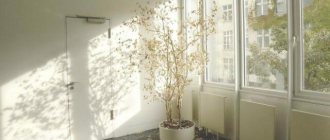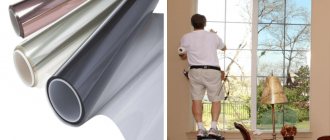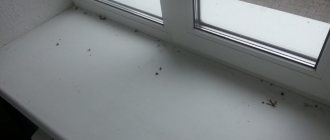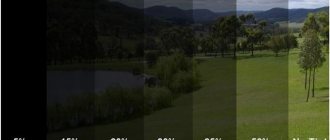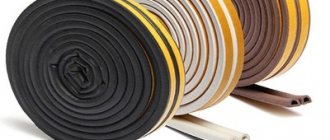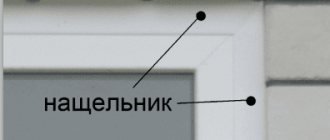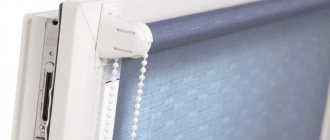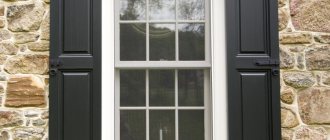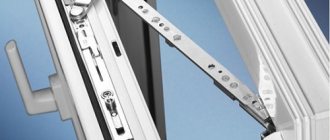Solar control film for windows
Sun protection film on plastic windows is one of the most common ways to protect against heat. It has a metal-based coating that gives it reflective properties. The film is glued to the glass and reduces the penetration of sunlight into the room.
There are different types of protective film: mirror, tint, athermal. They differ in their reflective ability, density, and thickness. Consider these factors when choosing.
Advantages:
- Tinting film blocks up to 75% of daylight, depending on the degree of tint.
- Athermal film blocks up to 95% of infrared rays.
- Mirrored solar control film for windows reflects the full spectrum of sunlight well and provides additional privacy, since the room is not visible from the outside.
Flaws:
- Covering windows with solar control film and removing it at the end of the season can be difficult.
- Short service life - from 1 to 5 years.
- Tinting film absorbs and mirror film reflects visible light, darkening rooms and necessitating the use of artificial lighting during the day.
- The tinting film also absorbs heat rays, increasing the temperature of the glass, which can burst if overheated.
- Inexpensive film peels off during use and rolls up at the edges, which gives the window an untidy appearance.
Does foil on windows help with the heat?
Foil on windows from heat is a budget-friendly way to protect. It reflects heat, so the room does not heat up. Everything else can be attributed to shortcomings
method:
- Food foil is opaque, daylight does not penetrate into the room, artificial lighting is required.
- The windows look unaesthetic.
- When pasting and removing foil there is a risk of damaging the glass.
- Tendency to “stick” to the glass, which complicates the removal of foil in the fall.
Purpose and varieties
The purpose of this type of film is to reduce the amount of sunlight entering the room and protect the room from overheating in the summer. In winter, mirror film reduces heat loss and also hides household members from prying eyes.
Sunscreen window film increases the strength of glass, thereby increasing the safety of people in the room. There is no need to be afraid if the glass breaks; pieces of glass remain on the adhesive surface.
Solar control film for windows comes in the following types:
- reflective films of medium and high efficiency;
- light-protective;
- sun protection;
- self-adhesive
- mirror;
- matte;
- protective.
Reflective film
| Average efficiency | High efficiency |
| Reflects 60% of sunlight. Available in blue, green, gray colors. They have the effect of a mirror with one-way visibility. | It has a layer of metallized coating, allows daylight to pass through well, but does not allow the flow of solar energy to pass through, and the windows remain cool, despite the high air temperature. Has good weather resistance. Not afraid of low and high temperatures, moisture, dust, dirt. Used for medium and large windows. Shelf life: 15 years. |
Sun protection film
This type is available with a thin metal coating, bronze, stainless steel or titanium, its color depends on this. Reflects up to 99% of UV rays in summer and prevents heat loss in winter.
There are films that are glued to the inside of the window; this model transmits daylight worse and is not as transparent as types of more professional quality. They are also called “interior”. Designed for office and residential windows.
Light protection film
It has the effect of one-way visibility, protects against ultraviolet rays, and prevents walls from fading. It has a long service life and good strength. It is resistant to temperature changes, humidity, and mechanical damage. Easily sticks to windows.
Self-adhesive mirror film
It has quite wide application possibilities. It is used for decoration, protection, and reflection of sunlight. Available in chrome, gold or steel.
Mirror sun protection film is easily and simply glued to windows and this is its feature. It is resistant to moisture and has a large selection of colors. Usually used in the decoration of shop windows, windows, for the purpose of advertising on the windows of shops, offices, the material is popular in the design and decoration of furniture.
The polymer coating performs a protective function and prevents mechanical damage to the glass. If it breaks, the small fragments will not fly apart, but will remain on the adhesive base. This prevents injuries to nearby people.
The disadvantages of self-adhesive mirror film are that it is difficult to remove and can stretch over time. Before dismantling, read the rules on how to remove the solar control film from the window if it has dried.
Matte film
This type is glued to windows and glass doors that are located indoors. Performs the function of protection from sunlight and increases the strength of the glass surface. Often this option is used instead of purchasing expensive double-glazed windows.
Sun curtains on apartment windows
Solar curtains for plastic windows successfully protect the room from the penetration of sunlight. Curtains made from dimout fabric provide the best sun protection.
Dimout differs from ordinary curtain fabrics by the presence of a special satin weave made of polyester fiber. It provides the curtain with the ability to block and disperse 70-90% of the sun's rays.
Advantages of dimout curtains:
- Wear resistance, resistance to fading.
- Thermal insulating properties.
- Dust-repellent properties.
Dimout
– dense material that holds its shape well and drapes easily. Therefore, the curtain looks beautiful and fits easily into the interior.
Another option for fabrics for solar curtains is blackout
. The material is coated with a special compound that can reflect the sun's rays. Blackout curtains protect from ultraviolet radiation, heat, and are completely opaque.
The type of curtains also affects the protective characteristics. Roller blinds provide good sun protection
. The lowered canvas completely covers the window opening and does not allow sunlight to pass through. To ensure a tighter fit, magnets are used at the bottom to which the weighting agent is attracted. When opened, the panel is screwed onto the shaft, so the light transmission can be adjusted.
Roman blinds have similar properties.
. They can be attached directly to the profile of a plastic window using a suction cup or Velcro. Roman blinds are made from different materials: linen, mixed fabrics, polyester, viscose, fiberglass, etc.
Using curtains to protect from the sun and heat has many advantages.
:
- Adjustable degree of sun protection.
- Aesthetics.
- Possibility to combine different types of curtains.
- Easy care.
This solution also has a drawback.
. If the windows face south, the curtains will have to be kept closed at all times. Even a sunshade made of translucent materials does not transmit light well. With blackout curtains, the room will require artificial lighting.
Advantages and disadvantages of reflective film
This kind of device has positive and negative sides.
pros
Compared to curtains, solar control film for windows has the following advantages:
- no need to wash;
- do not gather dust;
- do not get wet;
- protects the room from overheating;
- in winter they retain heat;
- protects walls and furniture from fading.
Another positive quality: you don’t have to worry about the plants getting too much sunlight.
Solar control films for window glass with a mirror effect protect people who are indoors from prying eyes. This type of window will not spoil the interior of the room. You can safely hang any curtains and curtains.
Minuses
- It is not always easy to clean window glass from solar control film if it is of poor quality. Such a fake quickly fades, stretches, and deteriorates when exposed to moisture.
- Thin material can be easily damaged when cutting.
- At night, when the lights are on, the windows become transparent, so it is better to cover the windows with curtains or use blinds.
But, compared to the positive aspects, there are few negatives. If you get a defect, before removing the film, you need to familiarize yourself with how to remove the sun protection film from the glass correctly.
Sun blinds for windows
Solar blinds on plastic windows also help cope with indoor heat. There are several types of blinds:
Horizontal.
The classic version with horizontally located slats. Can be mounted on each sash and combined with fabric curtains.
Vertical.
The slats in such systems are located vertically. At the bottom they are fastened with a cord or chain and weighted with weights. Thanks to this, the blinds completely cover the opening.
External.
They are attached to the outside of the window. When closed, they provide protection from the sun and heat.
Cassette.
They fit tightly to the window and provide good protection from sunlight. Suitable for rooms with large window openings and loggias.
The blinds provide complete darkness of the room; by changing the angle of the slats, the light transmission can be adjusted. Due to the fact that they are made of polymer materials, they are easy to care for.
Flaws
using heat-reducing blinds on windows:
- They provide poor protection from the heat, since the air heated between the window and the blinds freely penetrates into the room through the slats.
- The 90-degree angle of the slats makes the blinds completely light-tight; artificial lighting will have to be used in the room.
- Dust accumulates on the slats of horizontal blinds.
Installation of reflective film
Before you start work, you need to prepare everything you need.
Tools for work
To apply the sun protection film you will need the following tools:
- a scraper designed for washing windows;
- spray;
- stationery knife;
- scissors;
- rubber spatula;
- ruler;
- detergent,
- lint-free fabric.
The water used is ordinary, purified.
General rules for gluing film
It is advisable that the weather be sunny during installation; at this time the glass is warm, which has a positive effect on gluing. Before gluing the solar control film to the apartment window, you need to do a wet cleaning.
Cleaned glass should be free of lint. When cutting, you need to leave a margin of 3 mm on each side. At the end of gluing, you can trim off the excess with a sharp knife.
Where to glue
Sunscreen window film is used for covering residential windows, offices, industrial buildings, and shop windows. There are models that are glued to the outside or inside of the room. Using mirror self-adhesive film, furniture and store windows for advertising are decorated.
Glass gluing technology
It is advisable to install solar control film on glass that is pulled out of the frame. But this is not always possible, so installation usually takes place directly on the windows.
When gluing, the air temperature should be between +4 and +40. If the room is colder, the glue will take a long time to dry, but in hot weather it will dry quickly. Recommended air humidity is from 20 to 80%.
Stages of preparing a window for pasting:
- Wash the glass with baby shampoo.
- If there is dried dirt, use a scraper to clean the glass.
- Remove glazing beads, if any, and wash them.
- Before pasting, wipe with a clean, lint-free cloth.
Film gluing process:
- Measure the glass.
- Check the quality of the material, make sure there are no gaps, unroll the roll and turn it towards the light.
- Using a ruler and pencil, make markings and cut out carefully so as not to tear the film.
- Wet the glass with soapy water using a spray bottle.
- Remove the protective layer from the film and moisten the window with water to neutralize the action of the glue.
- We attach the upper edge to the glass with the adhesive side and smooth it smoothly, removing all the bubbles.
- Using a spatula, we expel all the air; if it still remains, you can lift the film a little and get rid of the bubbles. Just do this quickly so that the glue does not dry out.
- To control, you need to go through the spatula again, especially along the edges.
- Trim off the excess with a knife.
You can look at your work from the outside and once again check the quality of the pasting.
Solar control glass for windows
The best solution from the heat is solar-protective double-glazed windows
. They use either mass tinting of glass, which weakens sunlight, or special ultra-thin spraying. In the latter case, several nanolayers of different metals are applied to the glass. Thanks to this, glass acquires both sun-protection and heat-saving properties, becoming multifunctional.
| In summer, a multifunctional double-glazed window reflects up to 60% of thermal radiation from the sun. In winter - reduces heat loss through windows by 50-60%. In this case, the coating does not in any way affect the light transmitting properties of the glass. It remains transparent and allows daylight to pass through. |
Multifunctional double-glazed windows are suitable for any objects. They can be installed in residential premises, attics, on terraces and loggias, in winter gardens, etc. In this case, you will get windows that keep out the heat in summer and retain heat in winter. Your home will maintain a comfortable temperature all year round. By reducing the cost of heating and air conditioning, the cost of double-glazed windows pays off in a couple of years.
If you decide to install sun-protected windows, you need to take care not only of the choice of double-glazed windows, but also of the profiles. White profiles or bindings in light lamination are practically not subject to heat. At the same time, frames made of colored profiles in dark colors heat up much more strongly from direct sunlight, which can cause their deformation. To prevent overheating of the color profile, the following measures are recommended:
- Make temperature compensation holes in the profile to ventilate external chambers and remove excess heat.
- When making colored windows, use thicker and more rigid profile reinforcement, which is well resistant to temperature deformation.
Remind the manufacturer of this when ordering, especially if the windows face south or you live in an area with a hot climate. And then reliability and durability will be added to the sun protection properties of your windows.
FAQ
How to stick solar control film on a window?
Wash the window. Cut the film with a small allowance around the edges. Remove the protective layer from the top of the workpiece and glue it to the glass. Distribute the film around the perimeter of the opening and smooth it from the center to the periphery.
Does film on windows help with heat?
Yes, the film, depending on the type, has properties that block the thermal spectrum of the sun's rays to varying degrees, so it helps to slightly reduce the temperature in the room.
How does solar control window film work?
Due to the metal coating, the film reflects infrared rays. This reduces heating of the room.
Which side should I stick the solar control film on the window?
You need to glue the film on the side that is protected by the paper. Under it there is an adhesive layer.
How to clean window glass from solar control film?
Glass can be cleaned of adhesive residues using mechanical or chemical methods. In the first case, special scrapers for glass surfaces are used. When using the chemical method, solvents are used (white spirit, technical alcohol), but contact of solvents with plastic should be avoided. Read more about caring for plastic windows in our article:
How to remove sun protection foil from windows?
Remains of foil can be removed from the glass using a scraper for glass or glass-ceramic surfaces or an alcohol-based window cleaner. Use abrasive cleaners with care to avoid scratching the surface of glass and plastic. Read more about window care in our article:
How to glue sun shades to windows?
You need to stick it on a washed window. Wet the surface with soapy water. Cut the curtain film to size and remove the protective layer. Place the film on the glass and expel any air bubbles from underneath it.
What types of sun blinds are there for plastic windows?
You can install internal (with horizontal or vertical slats), external, or cassette blinds on plastic windows.
Should you open windows in hot weather or not?
In hot weather, there is no need to open the windows, since warmer air from the street quickly penetrates the room, warming it up even more.
Can a window burst due to heat?
Theoretically, maybe. Uneven heating, exposure to high temperatures, and temperature changes can lead to cracking. Uneven and excessive heating can be caused by glasses, films, coatings and screens with dark tints that absorb rather than reflect heat.
Sun protection film for windows. How we ruined our glass
Let's start in order.
There are different types of solar control film for windows. It varies in tinting density, spray color, method of installation and removal from windows. Physically, window film consists of a regular transparent film on which a thin layer of metal is sprayed. Moreover, the instructions clearly indicate that the film should be glued to the glass using this “metallic” layer. If you stick it the other way around, then firstly, the effect of reflecting sunlight will not be achieved, the effect of the film in this case is much lower, and secondly, it cannot be peeled off from the glass. If you turn to professionals for help, they will come to your home or office and stick the film on the windows themselves. Moreover, they use reliable, proven film and know how to glue it so that there are no bubbles left and the window does not lose its transparent properties. A well-adhered film is not even noticeable on the glass and its presence can only be detected by opening the window and making sure that the street is much lighter than it seems.
But professional services are expensive, and good film costs a pretty penny. So, for example, if I have seven windows in my apartment, then applying the film by professionals turns into a very significant waste. When I took the prices and received a price for the service that was in the five figures, I felt a little uncomfortable. The desire to save money and make do on our own grew stronger with every sunny day. Looking ahead, I can say that it would have been easier to immediately install climatic double-glazed windows with silver coating and argon inside and forget about the problem for many years.
Well, to be completely honest, I don’t really trust professionals, because quite often among them there are random people who will do the job according to the principle of a blunder, and if you start to be indignant, they will send you away. I’m not a brawler by nature, but I’m already a little tired of “wiping up the puddles” of so-called professionals.
Therefore, when another spring arrived, and the sun powerfully reminded itself, I headed to the store to buy window film. This kind of film is now sold in almost every hardware store. And then it was a terrible shortage. Therefore, I was very happy when I managed to find and purchase several rolls of the coveted product.
This is the film I managed to buy.
I hope by now this manufacturer has gone bankrupt and ceased to exist. At least his website is no longer open. I developed such a “kind” attitude towards a representative of the domestic industry after using his miracle products.
The fact is that the metal layer on the film was applied extremely unevenly. There were places with a very thick layer, while in others there was practically no layer.
Let's ignore the fact that I didn't glue the film onto the glass very carefully. This was the first experience. There were still bubbles that, no matter how hard I tried, I couldn’t get rid of. I know that a real professional would be horrified and would make an appropriate verdict about my mental incompetence :). The problem shown in this image is the uneven density of the metal layer. In fact, there are three pieces glued here at once. Notice the wide piece on the left. On the left side it is quite normal, but the closer to the right edge (in the middle of the window), the more transparent the film becomes.
The most amazing thing was that this unevenness was discovered after the film was glued to the window . I pasted it using ordinary water. Just not from the tap - we have a lot of bleach and other nasty things there - but clean spring water.
I didn’t want to go for another batch of film, which could turn out to be just as successful. The film remained stuck to the glass all summer. In principle, in part it really saved me from the harsh rays of the sun in the summer.
But the main “ambush” awaited me in the fall, when it was time to shoot the film.
In those areas where the metal layer was normal, everything went without complications. But the areas devoid of the metal layer turned out to be tightly stuck to the glass. Even in the summer heat, I noticed that the film was very hot from the sun. Apparently the layer adjacent to the glass has softened a little and “grabbed” tightly.
In order to scrape off the protective film, I had to use tools. Naturally, the surface of the glass was scratched. Then banal claws were used :). Things went faster and without scratches on the surface. The film was removed in small pieces and was completely transparent:
On one window on the balcony, I never bothered to remove the film from the glass. I just wouldn't have the patience.
I called the manufacturer at the phone number indicated on the package. The director himself answered. I started telling him about the problems with his products, but he wasn't very impressed. After swallowing another piece of sandwich (he was constantly eating something during the conversation), he suggested that I go to court and hung up.
Of course, I didn’t go to court. A roll of film cost about 60 rubles, but the fact that I spent a lot of time and ruined the windows removing it still had to be proven. Apparently the manufacturer knew that no one would sue him over these kopecks, so he could safely send everyone to court, and he himself would drive out the defect with complete impunity.
This happened in 2010. Since then, I have not supported the Russian manufacturer, but have been buying imported German film from EMTEC. Sticks on and removes with one touch. No bubbles or “undeveloped” areas% experience is a gainful experience. No problem, although it costs four times more.
There is a Russian film with similar quality:
Sometimes I buy it.
But now I’m already a scientist: before I start putting film on the windows, I first roll out the roll and look at it against the light. Fortunately, we haven’t come across any more such “successful” rolls yet.
And one more thing: it is better not to glue the film onto the glass, but to attach it to the frame using tape. This is more convenient, there are no bubbles left and then, after removal, you don’t have to wash the windows to remove streaks.
So, window tint film, Beware of counterfeits and machinations of domestic manufacturers. If you really can’t bear the heat, spend a little more and order a sticker from a trusted company. Or consider installing spray-coated double-glazed windows. They have many interesting features that you are not even aware of. At the same time, you will save on heating.
